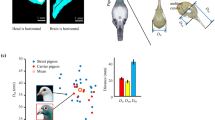Abstract
To study the modulation mechanism of the middle brain of the Gekko to the locomotion, we introduced a stereotaxic method first in literature and developed an apparatus suitable for Gekko gecko, the biggest wall and ceiling climber in nature. We defined the bregma and nasal points as reference points, selected the bilateral infraorbital margin and top point of the maxillary tooth for locating and fixing, and set up the line passing through the bregma and paralleling to a line connecting the bilateral infraorbital margin as x axis. Then, we defined a horizontal plane in the stereotaxic instrument, passing through x axis and the certain point which is 4.8 mm exactly above the nasal point, as the XOY plane; the sagittal plane, i.e. the YOZ plane, is the plane which is perpendicular to x axis and passes through the bregma; the plane, i.e. the XOZ plane, which passes through x axis and is perpendicular to the horizontal plane is the coronal plane. We designed a set of head holder which includes three parts: bilateral infraorbital margin clamps, a gecko adaptor holding the rostral side of the upper jaw. The allocation and operation of the head holder is accurate and simple, and the device is low in cost and compatible with standard stereotaxic instrument.
Similar content being viewed by others
References
Autumn K, Liang Y A, Flsieh S T, et a1. Adhesive force of a single gecko foot-flair. Nature, 2000, 405: 681–685
Dai Z D, Sun J R. Research progress in gecko locomotion and biomimetic gecko-robots (in Chinese). Prog Nat Sci, 2007, 17(1): 1–5
Zaaf A, Van D R. Limb proportions in climbing and ground-dwelling geckos (Lepidosauria, Gekkonidae): A hylogenetically informed analysis. Zoomorphology, 2000, 121: 45–53
Rizzo N W, Gardner K H, Walls D J, et a1. Characterization of the structure and composition of gecko adhesive setae. J R Soc Interface, 2006, 3: 441–451
Geim A K, Dubonos S V, Grigorieva I V, et al. Microfabricated adhesive mimicking gecko foot-hair. Nature Mater, 2003, 2(7): 461–463
Dickinson M H, Farley C T, Full R J, et al. How animals move: an integrative view. Science, 2000, 288(7): 100–106
Dai Z D, Zhang H, Zhang M, et al. Biomimetic study of discontinuous-constraint metamorphic mechanism for gecko-like robot: concept and model. Chin Sci Bull (in Chinese), 2007, 52(1): 1–4
Guo C, Dai Z D, Sun J R. Current status and prospect of research on bio-robots. Robot (in Chinese), 2005, 27(2): 188–192
Talwar S K, Xu S H, Hawley E S, et al. Rat navigation guided by remote control. Nature, 2002, 417(2): 37–38
Horsley V, Clarke R H. The structure and functions of the cerebellum examined by a new method. Brain, 1908, 31: 45–124
Karten H J, Hodos W. A Stereotaxic Atlas of the Brain of the Pigeon (Columba livia). Baltimore: Johns Hopkins Univ Press, 1967
Li Y C, Ma J C. Animal Physiology and Comparative Physiology Experimentation (in Chinese). Beijing: Higher Education Press, 1989. 275–279
Liu X Y. The anatomic research to the inner ear in Shinisaurus corcodiluus and Gekko gecko. Anat Res (in Chinese), 1999, 1: 4–7
Distel H. Behavior and electrical brain stimulation in the green iguana, Iguana iguana L. I. Schematic brain atlas and stimulation device. Brain Behav Evol, 1976, 13: 421–450
Greenberg N. A forebrain atlas and stereotaxic technique for the lizard, Anolis carolinensis. J Morphol, 1982, 174: 217–236
Del Corral J M, Miralles A, Nicolau M C et al. Stereotaxic atlas for the lizard Gallitia Galloti. Prog Neurobiol. 1990, 34: 185–196
Chen Z K, Ding G. Dissection of the skeketal system of gecko. J Yunnan Agri Univ (in Chinese), 1990, 5(1): 1–6
Yang A F, Cheng H. Comparative Anatomy of Vertebrates (in Chinese). Beijing: Peking University Press, 1999. 109–128
Wang W B, Dai Z D, Guo C, et al. A stereotaxic method and apparatus for the Gekko gecko. PRC Patent, CN1887238, 2007-01-23
Smeets W J. A forebrain atlas of the lizard Gekko gecko. J Comp Neurol, 1986, 254: 1–19
Wu G Y. Studies on the cytoarcgitecture and the connections of the pallial thickening in the lizard. Master Dissertation (in Chinese). Guangxi: Guangxi Normal University, 2003. 24–27
Paxinos G, Watson C. The Rat Brain in Stereotaxic Coordinates. 5th ed. San Diego: Academic Press, 2004. 7–12
Author information
Authors and Affiliations
Corresponding authors
Additional information
Supported by the National Natural Science Foundation of China (Grant Nos. 60535020, 30400086, 30570238) and Hi-tech Research and Development Program of China (Grant No. 2007AA04Z201)
About this article
Cite this article
Wang, W., Dai, Z., Tan, H. et al. A stereotaxic method and apparatus for the Gekko gecko . Chin. Sci. Bull. 53, 1107–1112 (2008). https://doi.org/10.1007/s11434-008-0175-y
Received:
Accepted:
Published:
Issue Date:
DOI: https://doi.org/10.1007/s11434-008-0175-y




